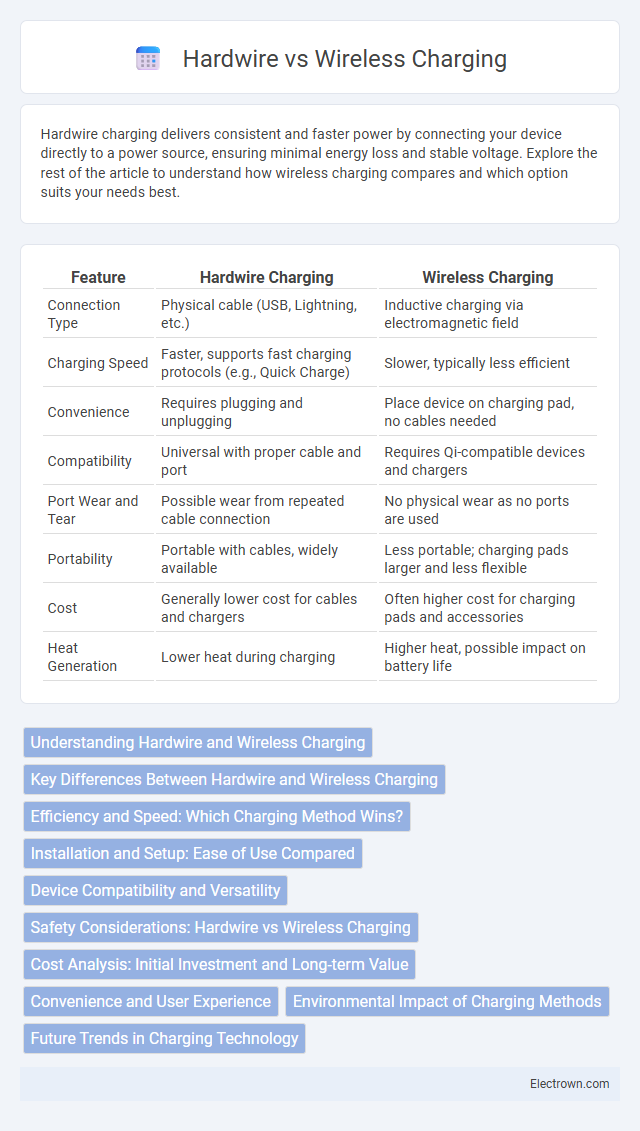Hardwire charging delivers consistent and faster power by connecting your device directly to a power source, ensuring minimal energy loss and stable voltage. Explore the rest of the article to understand how wireless charging compares and which option suits your needs best.
Table of Comparison
| Feature | Hardwire Charging | Wireless Charging |
|---|---|---|
| Connection Type | Physical cable (USB, Lightning, etc.) | Inductive charging via electromagnetic field |
| Charging Speed | Faster, supports fast charging protocols (e.g., Quick Charge) | Slower, typically less efficient |
| Convenience | Requires plugging and unplugging | Place device on charging pad, no cables needed |
| Compatibility | Universal with proper cable and port | Requires Qi-compatible devices and chargers |
| Port Wear and Tear | Possible wear from repeated cable connection | No physical wear as no ports are used |
| Portability | Portable with cables, widely available | Less portable; charging pads larger and less flexible |
| Cost | Generally lower cost for cables and chargers | Often higher cost for charging pads and accessories |
| Heat Generation | Lower heat during charging | Higher heat, possible impact on battery life |
Understanding Hardwire and Wireless Charging
Hardwire charging involves directly connecting your device to a power source using cables, ensuring faster and more efficient power transfer with minimal energy loss. Wireless charging uses electromagnetic fields to transfer energy between a charging pad and your device, offering convenience without cables but typically slower charging speeds. Understanding these differences helps you choose the best option for your device's charging needs and lifestyle.
Key Differences Between Hardwire and Wireless Charging
Hardwire charging delivers power through a direct cable connection, ensuring faster and more efficient energy transfer compared to wireless charging, which uses electromagnetic fields to transmit energy without physical connectors. Wireless charging offers the convenience of cable-free power delivery but typically results in slower charging speeds and requires precise alignment between the device and charging pad. Choosing between hardwire and wireless charging depends on your priorities for speed, convenience, and device compatibility.
Efficiency and Speed: Which Charging Method Wins?
Hardwire charging delivers superior efficiency and faster charging speeds, often charging devices up to 50% more quickly than wireless methods. Wireless charging typically experiences energy loss due to electromagnetic induction, reducing overall efficiency and increasing charge times. Your best option for rapid, reliable power restoration remains a wired connection, especially for high-capacity devices.
Installation and Setup: Ease of Use Compared
Wireless charging offers a hassle-free installation process, requiring only placement on a compatible charging pad without any cables, making it ideal for quick, plug-and-play use. Hardwire charging demands more effort during setup, involving direct connection to a power source with cables and often requiring installation of charging ports or adapters. Your choice depends on whether you prefer the simplicity of wireless pads or the consistent, fast connection of wired setups.
Device Compatibility and Versatility
Hardwire charging offers broad device compatibility, as almost all smartphones, tablets, and laptops come with standard USB or proprietary charging ports ensuring reliable power transfer. Wireless charging, typically based on Qi standards, supports a growing but more limited range of compatible devices, primarily recent smartphones and smartwatches, offering the convenience of cable-free energy transfer. Your choice between hardwire and wireless charging should consider the devices you use most frequently and the need for versatile, hassle-free charging options.
Safety Considerations: Hardwire vs Wireless Charging
Hardwire charging offers a direct connection with consistent power delivery, reducing the risk of overheating or electrical faults compared to wireless charging, which may generate excess heat due to energy transfer inefficiencies. Wireless charging pads often incorporate safety features such as foreign object detection and temperature control to prevent damage, but improper alignment or cheap chargers can increase safety risks. You should choose certified chargers and monitor device temperature during charging to ensure optimal safety regardless of the method.
Cost Analysis: Initial Investment and Long-term Value
Hardwire charging systems typically have a lower initial investment due to the affordability of cables and simpler installation processes. Wireless charging requires higher upfront costs for specialized pads and receivers, but offers long-term value through convenience and reduced wear on device connectors. Evaluating total cost of ownership involves considering factors like durability, energy efficiency, and replacement frequency.
Convenience and User Experience
Wireless charging offers enhanced convenience by eliminating the need for cables, allowing users to simply place their devices on a charging pad for effortless power replenishment. Hardwire charging typically provides faster charging speeds and consistent power delivery, which benefits users prioritizing efficiency over portability. User experience with wireless charging is improved by reduced wear on device ports and cables, while hardwire charging remains preferred for situations requiring quick and reliable energy transfer.
Environmental Impact of Charging Methods
Hardwire charging typically consumes less energy during power transfer, resulting in a smaller carbon footprint compared to wireless charging, which tends to waste energy as heat. Wireless charging devices often require more frequent replacements due to wear and inefficiency, contributing to electronic waste. Your choice between hardwire and wireless charging can influence overall environmental impact, with hardwired options generally being the more eco-friendly solution.
Future Trends in Charging Technology
Emerging trends in charging technology emphasize rapid advancements in wireless charging with increased power efficiency and extended range through resonant inductive coupling and radio frequency energy transfer. Hardwire charging continues to evolve, prioritizing ultra-fast charging speeds and integration with smart energy management systems to optimize battery health and reduce power consumption. The convergence of these technologies points towards hybrid charging solutions combining the reliability of wired connections with the convenience of wireless access in next-generation devices.
Hardwire vs Wireless charging Infographic

 electrown.com
electrown.com